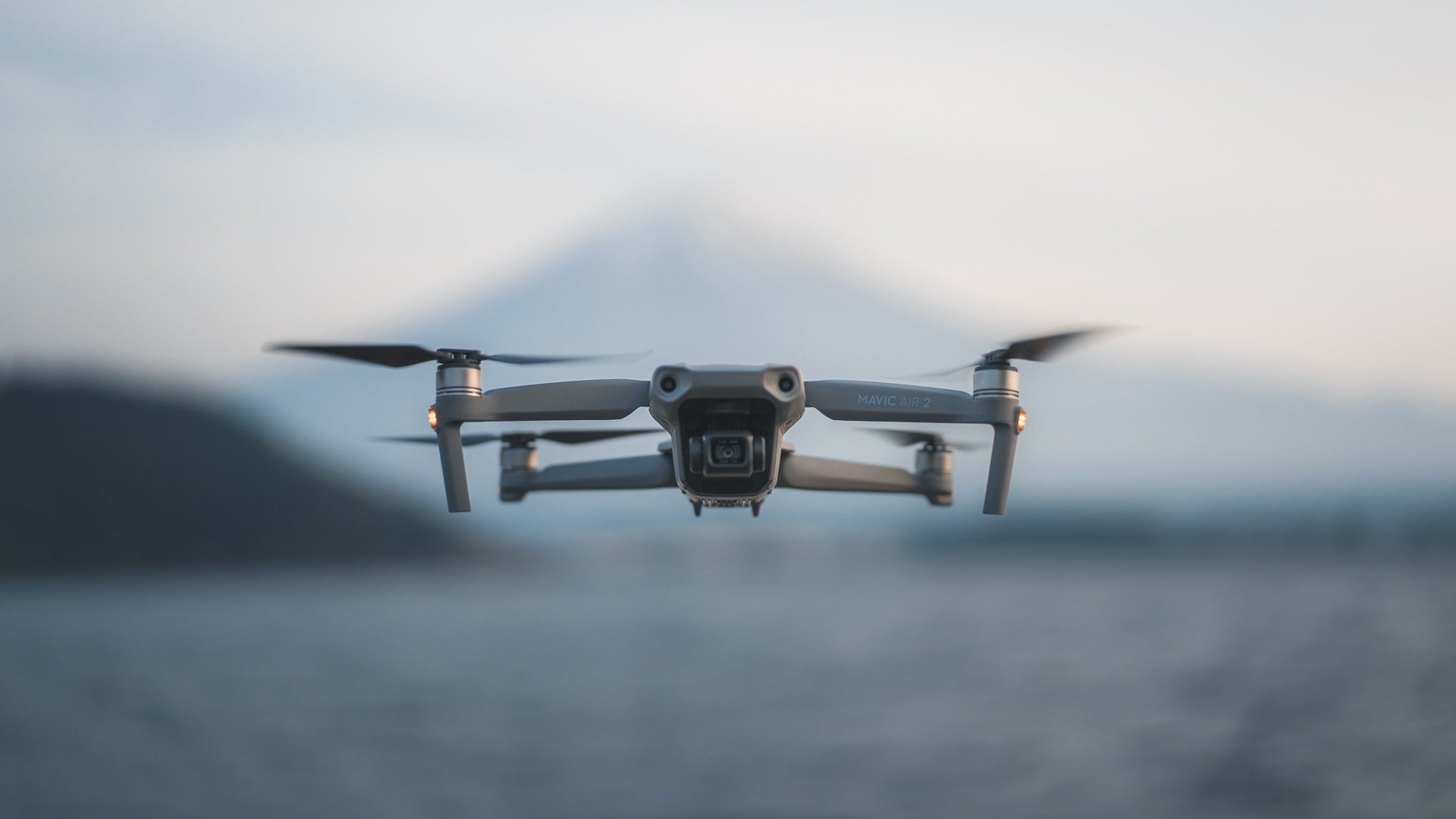The Mavic Air 2 is the drone most people should buy.
Okay, review done. Kidding.
2018’s original Mavic Air was the first of its kind, with decent performance in an impossibly small body. I actually kind of loved it. It had great charm.
However, it was plagued with problems.
Although it had fantastic video quality and the size was travel friendly, it was brought down by a dinky gimbal, average image quality, poor wind resistance, and terrible signal issues (let’s never go back to WiFi connection for remotes again, hey, DJI?).
But with the Mavic Air 2, all of those issues are gone and I’m pleased to say that DJI has created a fantastic drone that most people should buy.
What’s changed in the Mavic Air 2?

Well… everything, pretty much.
If you’re looking for the full spec list, visit DJI’s website, but these are the most significant changes you need to know:
- It has a new body that visually brings it in line with the rest of the Mavic series
- An all-new camera sporting a spiffy 48MP 1/2 inch sensor
- An all-new 24mm f2.8 lens
- Video recording up to 4K/60
- Significantly improved battery life (34 minutes flight time)
- A new remote
- OcuSync 2 (thank you)
- And way more
There’s plenty of other reviews online that go into some of the more intricate details and flight modes and such. However, the rest of this review assumes you’re at least a little bit familiar with DJI’s amazing suite of automatic capture modes that are great for beginners, and as such covers more of the things photographers and videographers are more concerned with.
On that note, let’s start with the most important thing for us image nerds:
Image quality
The new 1/2” 48-megapixel sensor is much improved over the previous version.
For you Mavic 2 Pro owners out there, don’t worry. The Mavic Air 2 isn’t quite as good. However, it’s not far off. The resolving power and detail you get from this little guy is fantastic.
12 vs 48 megapixels

Details resolve surprisingly well in the SmartPhoto function; which is a mode that incorporates scene recognition. It automatically captures and merges multiple images together depending on the content of the scene and the lighting conditions.
However, if you’re a pixel peeper like me (and if you’re reading this, you’re probably a photographer anyway, so you’re probably at least a little like me, haha), the real benefit comes with shooting in the 48MP mode.
In this mode, the drone uses all the pixels to snap a huge, 48MP image, resulting in ~95+megabyte images.
Images shot in the 48MP mode are slightly sharper (vs the equivilent crop from a 12MP image), with less noise, and more natural colour. Although the processing DJI uses on the 12MP version is great for most occasions, I find that it artificially sharpens the image too much and adds too much saturation.
If you want the highest quality stills, shoot in 48MP mode.
The only downside is that the drone lags a little when taking these images, forcing you to slow down a bit and wait for the buffer before moving to your next composition.
It’s a small price to pay though, those large files are gorgeous.
Low light performance
The 1/2” sensor really helps the overall performance of the drone.
With maximum ISO limits of 3200 or 6400 respectively depending if you are shooting in 12MP or 48MP mode, there is significantly less grain produced in the new Mavic Air 2 over its predecessor in both instances.
This means you can shoot well after the sun goes down, and later than you should be flying anyway.
Video quality
As has been the case with every drone DJI has released in the last few years, the video quality is again, fantastic.
The Mavic Air 2 can shoot in 4K up to 60fps, and 1080p up to 240fps.
The footage that comes out of the video is sharp, but not over-sharpened like the previous model. Colours are natural and not oversaturated, and shooting in HDR significantly opens up another world of fidelity versus shooting even in D-Cinelike. DJI have really stepped up their game with HDR now.
The original Mavic Air was so small and so light that it really got battered around in the wind, occasionally ruining smooth movements and timelapse.
However, with the new body and slightly heavier chassis, the Mavic Air 2 flies steadily. In combination with modes such as the latest 8K hyper-lapse feature, the usual barrage of QuickShots, FocusTrack, and APAS 3.0, it’s seriously never been so easy to record stable, reliable, cinematic footage with just a few taps.
It’s this colossal suite of automated shooting modes that makes a drone a must have for filmmakers and videographers. Bad camera control just isn’t an excuse any more. And with image quality like this, everyone can capture great video.
The all-new Mavic-style body

The allure of the original Mavic Air was its size; tiny. No bigger than a phone when folded up.
However, this new drone has grown up a little. It’s bigger in all dimensions; roughly 1.25 times larger than its predecessor in length, width, and height. It’s also 140 grams heavier, for a total of 570 grams.
This extra bulk means that it flies much steadier and is far more resistant to wind than what it used to be, while still being quite small and definitely travel-friendly - huge ticks in my books.
It looks different too; the entire body has been visually restyled to resemble the rest of the Mavic lineup, joining the harder lines, blockier aesthetic, and grey-coloured paintwork of the Mavic 2 and Mavic Mini.
For better or for worse, the entire Mavic range now shares a common visual design language, and I can’t wait to see where they take it next (please make one in all black, thanks =D).
New remote
This part of the review has me torn.
On the one hand, I love the new remote; it’s chunky, it has excellent grooves to wrap your hands around, and it feels amazing to hold and operate. The phone is now on the top rather than the bottom, there are clever design elements like hidden cable management, a push-action phone holder, a dedicated function button, and integrated antennas.
But on the other hand, it’s huge.
Like, almost-twice-the-size-of-the-last-one-huge.
Remember the DJI Smart Controller? One of the things I loved about that, aside from the fantastic screen, was that it had heft to it; it felt great in the hands, and that feeling inspires confidence, especially for more beginner pilots.
However, I didn’t own it for too long; I sold it because it was bulky and heavy. Bag space comes at a premium when you’re travelling full time.
The new Mavic Air 2 remote feels just as chunky, which is to say it feels great, even though it’s not that heavy. But the actual silhouette of the device is quite large.
This may not be a consideration for some people; however, for me, it’s top of mind - something for you to consider.
The tradeoff, however, is that it comes with a brand new transmission system, something that certainly justifies the new remote design:
OcuSync 2
I can’t write a review about the Mavic Air 2 without mentioning how much of a saving grace it is that DJI decided to use OcuSync 2 in this new drone.
Seriously. The WiFi connection on the original Mavic Air was bad. It severely underperformed against even the very first Mavic Pro, and using it in different countries such as Japan (on 2.4ghz) would be a non-starter from the beginning.
The connection you have between your remote and your drone is a huge factor towards your overall confidence in flying it.
And OcuSync 2 is excellent.
At a stated 10km max transmission distance (6km in some countries), the Mavic Air 2 has enough transmission distance for you not to worry about it cutting out or fretting over poor connection in most cases.
While I wasn’t able to test the absolute maximum distance, I was able to test its connection several kilometres away. Comparing it to the Mavic 2 Pro, it performs almost the same; which is to say, it’s excellent and confidence-inspiring.
Flying the Mavic Air 2

Now, of course, the actual flying component of the drone experience is half the fun, right?
I’m happy to report that the extra heft and size together with the new DJI Fly app makes the flying experience for the Mavic Air 2 absolutely simple and fun.
In most respects, the Mavic Air 2 performs almost as well as the Mavic 2 in the air; slightly underperforming in overall top speed, but getting high marks for stability against wind.
It feels agile, very similar to the last Mavic Air. Combined with the responsiveness in sports mode, this makes flying the drone super fun. I still find myself draining out the last 10% of the battery flying around close and doing spin tricks until the battery runs out.
The other part of flying is the app that DJI is running.
I’m actually a massive fan of the DJI Fly app. It’s a streamlined, simple version of the bloated DJI Go 4 app, with new UI and fewer features presented simply.
The only gripe I have with flying it is that the DJI Fly app doesn’t allow you to adjust the yaw rotation speed; something that’s pretty huge for me.
I usually have mine set to be quite sensitive on the Mavic 2 because I know what style of shots I need to get. The sensitivity allows me to move from shot to shot quickly.
However, this is an issue with the app itself, and not so much a reflection on the drone itself. So take that with a grain of salt.
Mavic Air 2 vs Mavic 2
I know this question is going to come up for many people, and it was one of the things that was top of mind for me while reviewing this drone.
Here’s my spin on it:
The Mavic Air 2 is $799USD, while the Mavic 2 Zoom is $1169USD, and the Mavic 2 Pro is $1419.
In my opinion, if you’re in the market to shoot video primarily, or you don’t care about the absolute greatest stills quality (not video), then the Mavic Air 2 is a no brainer.
It’s that good.
So then the comparison is Mavic Air 2 vs Mavic 2 Pro.
Well, the Mavic 2 Pro stills quality is noticeably better. It has a bigger sensor, it’s sharper with a variable aperture, and it performs better in low light.
However, is it $620 better?
…probably not.
However, if you’re after the absolute best image quality out of a drone, then the money doesn’t really matter anyway, right? You’ll probably end up with the Mavic 2 Pro.
You won’t be disappointed with the quality of the stills of the Mavic Air 2 though. It really is fantastic.
tl;dr
If you’ve ever been on the fence about which drone to buy, it’s this one. Buy this one.
DJI has really hit it out of the park with this drone. It has the perfect blend of features and price. It checks all the boxes for most people: it has excellent IQ, it's small and travel friendly, it flies great, it has a reliable connection, and it’s priced very competitively.
For most people, newbie, amateur, or even professional, this is the drone for you.





0 comments